Text
Newsletter 013 - Co-creations & Interactions
Our thirteenth newsletter is now available, encapsulating a year brimming with participatory design, multispecies conversations, and community-led projects. From the Great Ormond Street Hospital's new entrance designed with patients and AI, to the cultural probing of the "State-less 無國界" exhibition, and engaging communities in low-carbon cuisines, our latest newsletter is filled with insights on interactive and participatory practices.
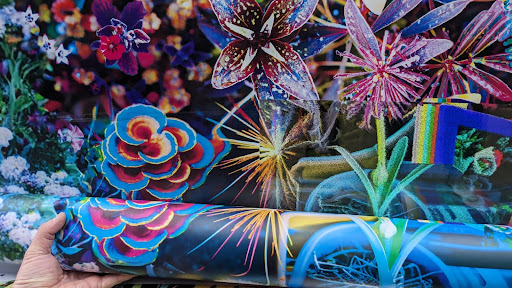
Read our latest newsletter, Co-creations & Interactions, to explore stories of intersections between people, technology, and the environment that have marked our journey this year.
Due to Tiny Newsletter's imminent closure, we're currently unable to accept new subscribers through the platform. If you're interested in keeping up with future newsletters, please email us at [email protected] to express your interest in subscribing. We'd love to have you on board!
#Newsletter#Co-creations#Interactions#InteractiveDesign#Multispecies#ParticipatoryDesign#CommunityEngagement#UrbanEcology#WiseCities#CreativeCollaboration#AI#Ownership
0 notes
Text
Newsletter 012 - Blurring Spaces
Our twelfth newsletter is out and filled with stories from our latest endeavours. The last few months have been teeming with projects and reflections. We included a shortlist announcement, a project blurring physical and digital realms, and another exploring interactions and interfaces with the non-human world, and more examples on designing for engagement and empowerment.

Read our newsletter, Blurring Spaces, and subscribe to get more on the work that Umbrellium is doing around the world and what’s going on in engaging cities and urban technology every other month right in your inbox.
#Newsletter#BlurringSpaces#CommunalInterdependence#NonHumanInterfaces#LiminalPlaces#OpenAir#ArchitecturalIntervention#EnvironmentalJustice#ResilientCities#ArtisticResearch#NewWaysOfOrganizing
0 notes
Text
Re:Wild Royal Docks
From 2020 to 2021, Usman Haque was Creative Director of Re:Wild Royal Docks, a ten-year vision for wilding East London, initiated by EdenLAB in association with Eden Project.
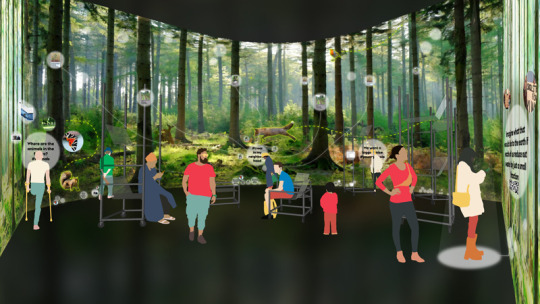
Rewild discussion, deliberation and decision-making space
Post by Usman Haque, original post at https://haque.co.uk/work/rewild/
Urban wilding is more than just improving access to nature: it involves redesigning urban infrastructures to account for our non-human neighbours, so that we don't just co-exist, but, more importantly, that we are mutually supportive and generative. From 2020 to 2021, I worked with the EdenLAB team and a number of organisations around East London to develop a transformative vision for the area, focused on re-connecting people and the natural environment. Our work was sited at Royal Docks, London, but much of the learning can be applied to other urban contexts.
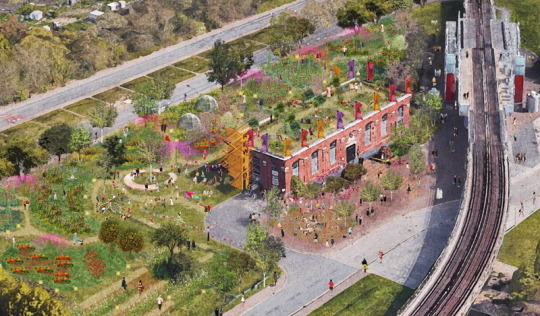
Proposed Rewild HQ, image by project architects Gort Scott
Challenges of Urban Wilding
Connecting an increasingly urban population to the natural world lies at the heart of humankind's successful response to the major environmental, social and economic challenges of the 21st century, which are particularly prominent in global capital cities. It may seem self-evident that everyone loves green cities, but there is no cross-cultural consensus on how, why and when to use green urban spaces, what they mean to different families or organisations, or even how local authorities should care for them. Ascribing agency (and in some cases citizenship) to non-humans makes the question of governance even more complex.
One person's lovely 'wild' meadow is another person's unkempt park suffering from lack of maintenance — or loss of a vital sporting resource — or apparent waste of tax-payer money. If this diversity of perspectives (and expectations) is not explicitly accounted for in the development and deployment processes of urban wilding schemes, evidence shows that they're bound to fail. This requires more than just consultation and engagement — active meaningful participation of communities in the decision-making processes is crucial, as well the ongoing governance of urban wilding.

Re:Wild Royal Docks primary rewilding site
A Strategic Approach to Urban Wilding
The strategic approach that I developed for
Re:Wild Royal Docks
combined greening of the urban landscape and improving biodiversity with a participatory approach to rewilding, getting people actively involved in making decisions about green spaces and systems, while getting them to feel a little 'wild' themselves.
Supported by the Eden Project, our aim was to get people excited, while retaining an emphasis on governance, accountability, and decision-making, all built on the science of environmental improvement and recent research on non-human intelligence and sentience.

Rewilding through growing, eating, learning, nurturing
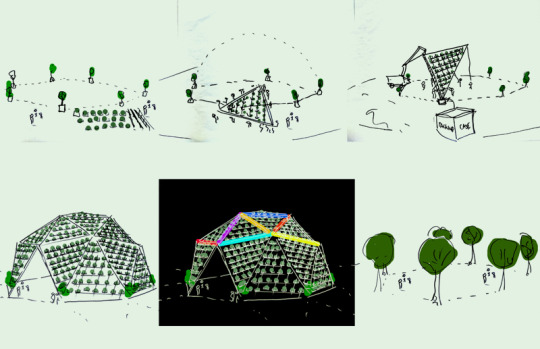
Rewilding through barn-raising
A key goal was to transform how local residents relate to each other and the natural environment, and empower them to make simple changes to their homes and neighbourhoods that improve environmental and sustainability factors. To help people get comfortable being 'wild' themselves, we designed a set of core activities to help them reassess their relationship to the natural environment, particularly those that reinforce connections between people:
EATING food together
GROWING plants at home
NURTURING (landscapes, non-humans, etc.) together
MAKING (things, decisions) together
LEARNING (about each other, non-humans, etc.) together
Rewilding is a fundamental strategy for tackling the Climate Emergency in cities. It needs a completely different perspective (to 'green buildings'; to participatory engagement in cities; to the deployment of urban infrastructure) from the approach that is usually adopted in urban development.
It requires more than just planting trees and flowers that improve pollination. It upends everything we think about public space (and who is responsible for it), challenges how we make collective decisions about food, and makes us far more conscious of the collective effect we have on the environment we all depend upon. It requires an integrated, holistic and inclusive approach to everything from buildings, parks and public spaces to homes, balconies and waterfronts — and even the concept of citizenship.
...
Re:Wild Royal Docks — A Ten Year Wilding Strategy
The Ten Year vision for Re:Wild Royal Docks included establishing:
A. Wilded Urban Spaces & Headquarters
Physical Headquarters at Royal Docks for urban wilding, with co-creation space, roof garden, food offering, event space and immersive interactive rewilding experience
Network of Green Spaces, Wild Places and Biodiversity Corridors across the borough — starting with the 12-acre area surrounding the HQ — with particular focus on soil remediation and biodiversity restoration to ensure thriving aquatic and woodland ecologies, and connecting together areas of the urban fabric to improve both human and non/human mobility
______________________________________________________________
B. Community Call To Action, New Facilities & Resources
Call to Action to get communities all over involved, with borough-wide outreach and education activities and curricula involving planetary care, tree planting, biodiversity restoration and the on-going stewardship of woodland ecologies locally
Cultural Innovation Destinations and Spaces set in the natural landscape, including a 'Rewild Kitchen' and Cafe in a tree-house, along with 'lectures in the landscape'
Green Business Cluster and Creative Hub in partnership with local universities
Community-led Workshop & Lab for Creative Production in urban wilding
Educational and Cultural Events Programme centred on rewilding and connecting humans and non-humans
Showcases for Local High-Tech Sustainability Systems including simple soil remediation schemes for local residents and businesses
Grant Scheme for Promoting Local Innovation in human/non-human cooperation and green infrastructures across the borough
______________________________________________________________
C. Technology Infrastructure for connecting Humans & Non-humans
Digital Masterplan designed around rewilding — instrumenting the landscape, creating a 'sixth sense' of the natural world, and a collective intelligence infrastructure to combine human, non-human, synthetic sensing
Digital Interventions and Deployments to augment human understanding of non-human systems, both indoors and outdoors — giving a 'voice' to non-human participants
Immersive Interactive Discussion + Deliberation Space connected to sensor networks and environments throughout the borough, hosting community groups making collective decisions on key issues to do with the Climate Emergency, informed by real-time environmental data
______________________________________________________________
D. Rewilding Activities & Related Events
Floating Farms, Adventure Play, Wild Swimming and other water-based stewardship activities
Human Wilding Activities such as tree-climbing/doctoring and beekeeping, both in the landscape as well as on the water
Annual Re:Wild Summer Festival to showcase participatory urban rewilding through arts and music as well as a conference
Annual 'Barn-Raising' Initiatives to co-create new low-carbon structures in the landscape in support of biodiversity
______________________________________________________________
E. Multi-species Governance & Stewardship Processes
Long Term Masterplan and Asset Register for local natural systems, ecosystem analysis, horticulture mapping, species-identification, etc. with a focus on exploring non-human citizenship, tree-planting/adopting schemes
Community Advisory Board and Governance Process, incorporating non-human participants, and a Rewilding Charter co-created with the local community
Youth Council for Human/Non-Human Cooperation in tackling the Climate Emergency
Formalised Processes for revitalising unused local assets including unused green spaces, allotments, unused buildings
...
Re:Wild Royal Docks Digital Masterplan
The base layer of the proposed masterplan was to instrument the landscape, non-human species and natural environments through sensor networks and monitoring stations, gathering data in order to provide a means for observing patterns of activity, interaction and response. This would contribute both to real-time data repositories as well as to a long-term register of local non-human species, natural systems and ecosystems (so that, for example, tree-planting schedules could support monitoring development, growth and change over the entire lifetime of a tree, and feed into air quality impact assessment for individual trees).

Human/non-human activity - interaction - response - conversation
This would be augmented by a second layer of interventions in the landscape that would enable members of the public (and, for example, students from nearby schools) to observe and 'listen in' on what was going on, beyond their usual thresholds of perception (e.g. visualising or sonifying real-time data and other augmented reality interfaces). Building on this active observation, and tied into design, technology and sustainability curricula, people would be able to contribute to making sense of the observations and (albeit in an anthropocentric way) give a "voice" to the non-human species around them throughout a set of activities that would generate additional multi-layered subjective metadata for the datasets.

Instrumenting the landscape & giving a 'voice' to non-humans
Finally, a third layer would integrate this sense-making approach with artificial intelligence pattern-recognition and creation, in order to combine human, non-human and synthetic systems into a collective-intelligence infrastructure. This would be manifested in an immersive and interactive physical space, connected both to the on-site network as well as sensor networks and environments throughout the borough. This space was designed to host local residents, community groups and businesses making collective decisions on key issues to do with the Climate Emergency, informed by real-time environmental data and input from non-human neighbours. In contrast to typical "smart city operations centres" that centralise surveillance and control, this would be an open space for discussion, deliberation and decision-making, uniting both humans and non-humans.
...
Urban & Community Transformation through Wilding
Although the scheme was eventually not taken through to implementation stage, much of the strategic approach (involving multiple layers of connection, co-creation and interdependence) applies more broadly to other urban contexts.
If a city is to be truly innovative, it needs to embrace the fullest creativity of its residents — human and non-human. It needs to consider new imaginative possibilities for informal urban green spaces, and show communities how they can nurture them alongside non-humans, bringing both tangible physical benefits as well as emotional and physiological benefits and strengthening the wellbeing of communities as a whole.
People often say they want their cities to be more "green", and understand that tree-filled parks and vegetation-covered buildings could make cities more delightful, healthy and sustainable. But what that means to different people is less certain and bringing such desires into reality is fraught with complexities — economic, social and environmental. How do we, collectively, bring about that kind of future? How can we navigate those complexities and overcome barriers — perhaps even discover that the barriers weren't so high? How can we all be part of the decision-making — and with that, take responsibility for a greener and more inclusive urban future we all co-create? Deliberately (and deliberatively) wilding the city offers answers to all these questions.


Rewild discussion, deliberation and decision-making space
The innovation of rewilding is so much more than just green engineering: in its decentralised nature it can offer a radically different approach to getting people involved with decision-making, one that necessarily includes embracing non-human intelligence and sentience. Through a coordinated rewilding programme, whether people are campaigning to turn unused urban space into community gardens, working to plant trees in their neighbourhoods, enjoying the health and well-being effects of birdsong or just planting a tomato seedling in a window-box, they can all understand they're part of a larger city-creation exercise. At its heart, rewilding can help reinforce confidence between local authorities and residents in a way that most engineering-focused 'smart city' programmes can never achieve, contributing to vital re-configuration of a range of existing infrastructures:
- Community/social infrastructures — engagement, agency, cohesion, education, upskilling
- Architectural & urban infrastructures — buildings, indoor spaces, landscape, vertical surfaces
- Technology & digital infrastructures — data, interaction, sensing, sustainability platforms
- Health, Environment & Well-Being infrastructures — active travel, biodiversity, food & sport
- Economic infrastructures — circular economies, local investment, value-driven impact

Rewild School, image by Public Works
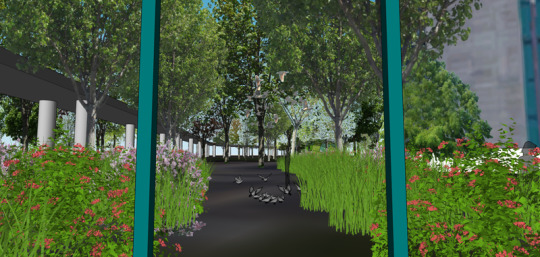


Rewild landscape augmentation

Giving a 'voice' to non-humans
...
For more on this topic, see videos and discussions below:
Wild Cities — with Rosanna Vitiello — 2021
What Will Our View of Nature Bring to the Future? — 2021
...
Core Team
Usman Haque — Creative Director, Re:Wild Royal Docks
Mike Wellings — EdenLAB, CEO
Peter Hampel — EdenLAB, Artistic Director
John Tellwright, Katie Maddison, Richard Dare — EdenLAB production team
With thanks to the following for their enormous contributions to the project and its development: Fiona Scott (Gort Scott), Chris Paddock (PRD), Suzi Martineau (Tree Sisters), Michael Brown (Asociat), Torange Khonsari (Public Works), Iram Quraishi, Stephanie Mechanic, Jeffrey P Davis, local community organisations and groups such as Growers Kitchen, Royal Albert Dock Trust and Green Hands, and all the teams at Royal Docks and London Borough of Newham who helped give context to the scheme.
And finally a massive thank you to all the rewilding practitioners and researchers around the world that are helping transform human/non-human cooperation. A key reference during development of this project was Rewilding - edited by Dr. Nathalie Pettorelli, Institute of Zoology, London, Prof. Sarah M. Durant, Institute of Zoology, London, Prof. Johan T. du Toit, Utah State University. Some of the initial thinking is described in this article: Making Cities Wild, building in particular on work by Bauer and von Atzigen; Maller, Mumaw and Cooke; Clayton; Dr Bridget Snaith.
#umbrellium#usman haque#news#Re:Wild Royal Docks#East London#participatory#city making#human-non-human relations#non-human citizenship#beyond coexistence#digital masterplan#participatory governance#multi-perspective#responsibility#agency#wild city#multispecies design
0 notes
Text
Umbrellium Shortlisted to Reimagine the Innovation District at Begbroke Science Park in Oxford

We are delighted to see Usman Haque as part of one of the five teams shortlisted for a master plan to transform the area around the University's Begbroke Science Park into a 190-hectare mixed-use Innovation District, to the north of Oxford. The project is also set to create a community of up to 2,000 quality homes, with new schools, a public park, and a nature reserve.
Our challenge is focused on the question “How can Begbroke be both global and local; a place of world-changing science whilst at the same time somewhere to call home?”
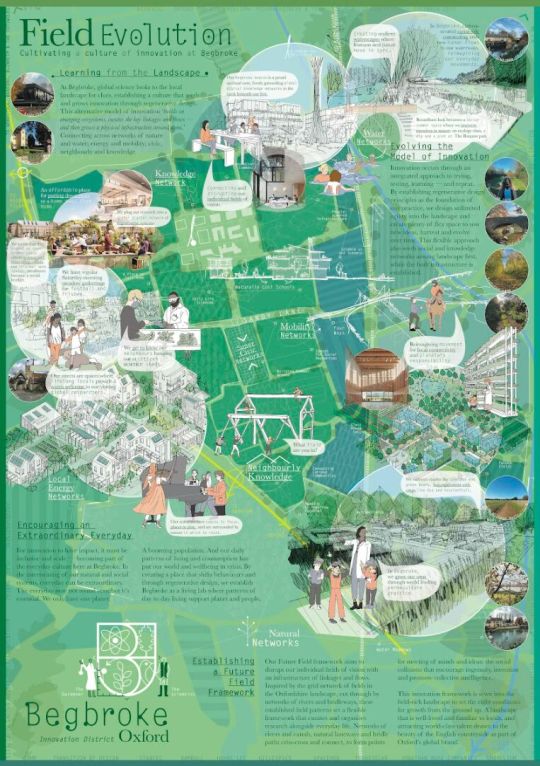
Image: Prior + Partners ‘Field Evolution' proposition
The ‘Field Evolution’ team that Prior + Partners is leading includes exceptional members: The Place Bureau, Alison Brooks Architects, WilkinsonEyre, dRMM, Gillespies (Oxford), Spacehub, Ramboll, Stantec, Hoare Lea, Transition by Design Co-operative (Oxford), Transsolar and advisory gurus: Keith Orlesky, Philipp Bouteiller, Pooran Desai, P+P's Jonathan F.P. Rose, and Usman Haque.
More information on the competition and participants in this article by Caroline Cole, Founder, and Director at Colander.
#news#announcement#engagedcities#publicrealm#placemaking#diversity#climate#innovationdistrict#universityofoxford#Oxford#UK
1 note
·
View note
Text
Pollution Explorers Collective Action
We show how a collective intelligence approach, that gets people working together on air quality issues, can help double impact.
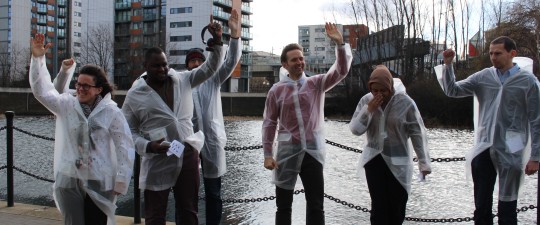
Air Quality (AQ) is a communal, collective and societal issue. While we don’t pretend that the responsibility lies solely with individuals to fix its problems, it’s clear that we do each have some part to play and that, in the absence of a strategic approach that each of us can be part of, a widespread sense of disempowerment could make it even harder to generate much-needed change.
Pollution Explorers Collective Action (PECA), funded by a Collective Intelligence grant from Nesta, builds on Umbrellium’s work on air quality issues with communities around Europe over the last 10 years. In previous projects, including WearAQ and Pollution Explorers, we found that, when people use their own innate senses and perceptions to evaluate air quality in their neighbourhoods, they seem to take more meaningful steps to try to be aware of and improve AQ than if they are just given AQ data or digital sensors. Something about activating the senses and getting physically involved seems to make AQ more conspicuous and tractable.
In PECA we wanted to go further than our previous projects, by working with a larger group of people over a longer period of time, and more specifically we wanted to look at whether groups of people provided with a platform to gather their ‘collective intelligence’ (for inter-group collaboration and communication) would perform better (in terms of AQ impact and commitment) than those who did not. It might seem obvious and self-evident that people working together would achieve more, but we had found little specific data on this — at least for complex community projects dealing with seemingly invisible environmental issues like air quality. PECA shows how, using a collective intelligence approach, AQ projects can double the impact per £ spent, compared to typical data/information AQ projects.
We hope this set of findings and suggestions for collective intelligence can help local authorities and other organisations develop more effective citizen-participation strategies on large-scale complex issues relating to the climate emergency. These might apply to a broad range of issues from managing city resources (e.g. use and maintenance of green spaces and parks) to larger scale environmental concerns (e.g. energy use, health). While most cities have allocated budgets towards air quality and how people move around cities (e.g. AQ sensor deployments), and in many cases have legislation in place, there are few viable programmes or methodologies for engaging ‘the hearts and minds’ of their residents, or programmes that result in measurable behaviour change. Legislation is a top-down force that has certain types of large effects. Our findings, building on work we have carried out with dozens of local authorities around the world, shows a need for a corresponding bottom-up and collective intelligence approach like PECA to get people actively and consistently invested in the aims of legislation.
. . .
Collaboration and Connectivity — More Effective than Data
AQ projects by local authorities, particularly in the UK, tend to rely on providing data and maps, occasionally offering strategies for tackling the issues, and even dashboards for tracking changes over time. ‘Typical’ projects use a combination of education, awareness-raising and information to try to bolster behaviour change in individuals. These ‘persuasive’ approaches and technologies to reduce pollution and promote behaviour change sometimes use competition and reward-based intervention to incentivise participation. However, there’s limited evidence of these approaches generating lasting impact. Data on its own does not inevitably lead to insight or action, especially when the focus is solely on individuals.
In our own work we’ve repeatedly seen that getting people to work together is more effective, so we wondered — if collective intelligence methodologies supporting collaboration and communication are such obviously useful strategies for improving impact — why is it that local authorities don’t choose to use them? A sense of collective empowerment is particularly crucial for dealing with air quality because it seems too massive and far beyond our ability to affect as individuals. On their own, people tend to have low confidence that others will make a similar effort, believing their efforts will have to be greater if others do not do enough. (We are seeing similar phenomena in the collective response to COVID.)
From our anecdotal evidence, collective and collaborative projects simply sound expensive, time-consuming, complex and risky for funders. Actively and regularly supporting a community and nurturing communication and collaboration between participants on an ongoing basis sounds like it takes a lot of effort and money, and could have uncertain outcomes. We wanted to challenge this assumption.
The PECA Experiment and What We Discovered
Working with dozens of London households across Tower Hamlets, Hackney, Newham and The City, over 4 months in early 2021 we provided participants with a set of 15 PECA Challenges that they could carry out — any number of them and as often as they wished. These challenges are known, at scale, to improve air quality and reduce greenhouse gas emissions. For internal calculations, we converted each of these into a carbon equivalent which on its own is inaccurate and not very useful, but which enabled us to make comparisons between activities and participants of relative impact, scaled effects and perceptual complexity across different challenges.
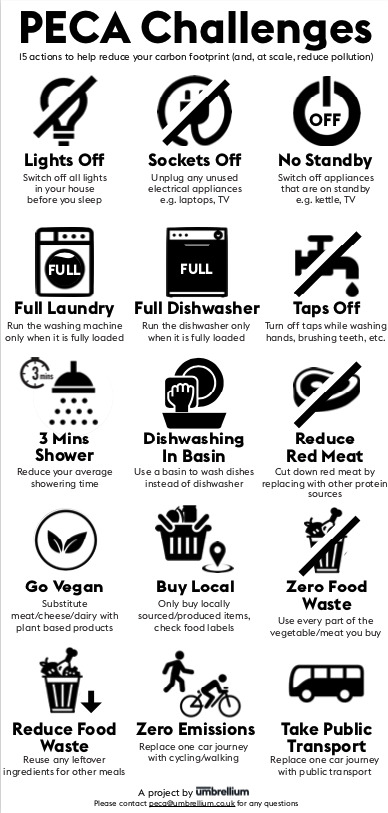
115 PECA Challenges from ‘3mins shower’ to ‘Go Vegan’
For example, switching off lights all the time is easy but has relatively little impact on AQ at scale, while going vegan is perceptually more difficult but actually could have massive impact if we all made the change. Participants could choose one or more of these challenges (or none) and carry them out as often as they wished, reporting back on their progress each week.

Diagram of Control Group and Experimental Groups
Participants were placed in groups of 8 to 10, with each group designated as either Experimental (using a collective intelligence platform to communicate and collaborate) or Control (no communication).
Each week, participants reported back to us on their progress with their challenges (and whether they wanted to change or drop) and in turn got a weekly summary of their group’s collective efforts. Unlike the Control group, Experimental groups were able to use our custom-designed Pollution Explorers SMS group messaging platform to communicate and share experiences, and also had a monthly zoom call when they could meet and talk directly with others in their group. They could also decide how they would interact and collaborate (or even compete if they felt it useful). We then tracked each group’s results on a weekly basis for the duration of the experiment.
Our analysis showed that the Experimental groups adhered to challenges longer, tended to adopt more impactful challenges, took on a wider variety of challenges and, over time carried out more challenges simultaneously each week than the Control group. While the Experimental groups were more expensive to run on a per-participant basis (taking more management time, incurring more network fees and infrastructure costs), the calculated impact per £ spent they had was almost double that of Control group participants.
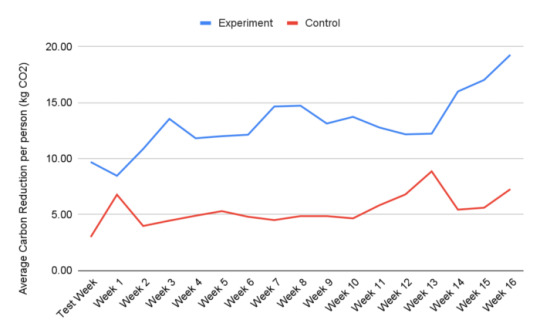
16-week graph of average carbon reduction in Control and Experimental Groups showing almost 4 times the total impact by the end of the experiment
. . .
One interesting finding was that, in the Experimental groups, when people tried vegan meals and started sharing recipes and reported to each other how delicious they were and how to source ingredients, there tended to be others in the group who would try it out as well, helping increase impact in an almost ‘viral’ way. We had originally assumed that people would change and swap their challenges from time to time, but instead we found that those in Experimental groups tended instead to keep their challenges and just add new ones, again multiplying the impact.
Apart from important findings regarding group dynamics and collective intelligence strategies, PECA also enabled us to compare the relative cost and complexity of a ‘typical’ air quality project, with one that made use of a seemingly more costly and complex ‘collective intelligence’ platform. This shows that for a given AQ project budget, running it as a collective intelligence initiative, getting people to work together, collaborate, communicate and cooperate, can have twice as much impact on air quality, at scale, as a ‘typical’ local authority AQ project.
Collective Intelligence Learnings for AQ and other environmental initiatives
When it comes to air quality (as with other environmental issues) it appears that people generally already know what the problem is, and even know how to resolve it, but there are significant disincentives to collective action:
When it’s a massive issue, people feel they cannot as individuals have a significant effect on it
They have low confidence that others will make a similar effort
Their efforts will have to be greater if others do not make an effort, so why should they bother if others don’t
At the heart of the challenge is how to motivate people to do things that they probably already know would be helpful, at scale, to do, but which they are disincentivised even to start. Through this experiment we have tried to tackle all three of these factors, and to show how providing people in our Experimental groups with means of cooperation and communication while making sense of and responding to the issue at hand (in this case air quality) can diminish the disincentives and increase impact for a given investment in project resources. We drew on research by Dr Gyorgyi Galik and others in developing our approach.
Disincentive 1 — Individuals’ perception of impact
Any time we provided a group with information, they were all given the same information, and it related specifically to group impact, not just individuals. We provided no individual feedback — so as not to cause a sense of competition or even shame among the individuals if they felt their performance was less than others. We also extrapolated from their own group’s performance to a larger scale so that they could understand what impact they would have made if their entire borough had performed at similar/proportional levels, so that they could appreciate how individual actions scale up to something more significant. This was to help them understand that as individuals they do have an effect.
Disincentive 2 — Confidence in others
Rather than requiring experiment group participants to share information we simply provided them with the means to share information — a group SMS platform. This enabled a more informal approach to cooperation and knowledge-sharing than a data entry system, and one which explicitly combined quantitative and qualitative contributions. While this could benefit from further investigation, our observation was that this informality (and allowing them to set their own terms for how and what they shared) seemed to help people get comfortable with each other and develop a robust confidence that others were trying to do things as well and that their efforts were similar.
Disincentive 3 — Impact on Individual effort if others don’t perform
We made this fact explicit — that it would be easier for everyone if everyone worked together — and offered this as a prompt to help others if anyone felt unable to complete a challenge, so that they didn’t feel a sense of shame, and others felt empowered to help. For example, when group communication was introduced we discussed how people could use it to ask others to help them with their challenges, or to swap challenges during a difficult week. This seemed to help people develop a sense of working on a collective goal, and that helping each other in the short term by taking on temporary extra burden was actually beneficial to all in the long term.
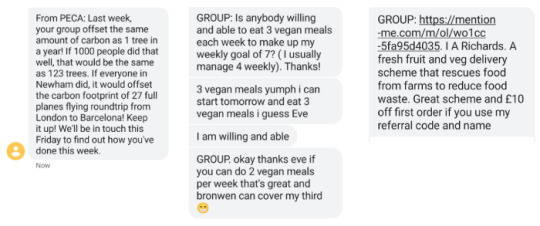
Screenshots of SMS messages between participants
. . .
Below is a list of strategies that could be applied to future AQ projects or other large scale environmental issues, benefitting from getting people to work together collectively.
Dividing up into groups limited to 8 to 10 seems to be useful because it means everyone in a group can get to know each other over the course of a few gatherings. Any larger and individual personalities could dominate.
Competition in groups only works for certain types of personalities. Enabling small groups of people to decide for themselves how they want to interact (e.g. collaborating vs competing) is more effective.
When people are working in a group, provide feedback for the entire group rather than individuals — so as not to cause a sense of competition or even shame among the individuals if they felt their performance was less than others, which can be disempowering and ineffective.
On complex environmental issues, people can feel disempowered by having too much atomised or individual information (unlike tracking your own weight, it can feel there’s no point in knowing how much you’ve affected AQ because your contribution seems so miniscule overall). Providing ‘scaled-up’ information about the impact they would all have if their neighbours and other borough residents did the same as them, seems to be more empowering and exercises the imagination. Even better, knowing what others are doing in conjunction seems to provide more encouragement.
People enjoy learning from each other and knowing how others are getting on with their challenges and commitments, as long as the communication is light touch, non-intrusive and does not require constant attention.
When people were engaged with what others were doing they also ended up trying seemingly harder (and more impactful) challenges knowing they were not alone (e.g trying vegan recipes)
Small incremental steps lead to more persistent change — by getting participants to ease into their challenges slowly (e.g start by doing a challenge once a week or less, then doing it more over a week as they get used to it), helps participants feel less anxious about keeping to their commitments.
We had expected some people to get bored of challenges and they were invited to propose their own alternatives, but nobody did, and took on the challenges offered. There is something about the psychology of risk taking that needs further exploration but when people got used to their challenges and knew that others were too, they tended to take on new challenges without dropping the previous ones.
Some participants suggested in future creating groups of people who already know each other or share common interests. This would presumably lead to more trust and interaction.
It’s possible that a local community ambassador or representative would work better to ‘manage’ the ‘collective intelligence’ platform and inter-group communication and collaboration than an external project organiser, since it would create a different relationship to participants.
By Usman Haque & Ling Tan
. . .
Pollution Explorers Collective Action is a project by Umbrellium, funded by a Collective Intelligence grant from Nesta. With thanks to Iram Quraishi & Babar Javed at Loop Labs our community partners, Usamah Khan our data scientist, and Dr Gyorgyi Galik for her research. For more information about Pollution Explorers Collective Action, or applying ‘collective intelligence’ to large-scale participatory projects, please get in touch.
. . .
And a special thank you to all the wonderful participants in East London that took part in the project — it was such a pleasure getting to know you a little and seeing how much you could all accomplish (even in the Control group!) — thank you for all your time and dedication!
. . .
This article was originally posted on Medium, on 28th October 2021. Visit https://uah.medium.com/pollution-explorers-collective-action-cd895d0e172d
#PECA#Collective action#air quality#local governance#collective decision making#sustainability financial model#community engagement#collective intelligence#participatory design#design experiment
0 notes
Text
Newsletter 009 Calls for Action and Participation
Our ninth newsletter is live. We are thrilled to share with our network what we’ve been up to in the past two months. We included a call for participants to join our next project, the delivery of an experiment exploring collective action to tackle air pollution and more examples on designing for engagement and empowerment.

Read our newsletter, Calls for Action and Participation, and subscribe to get more on the work that Umbrellium is doing around the world and what’s going on in engaging cities and urban technology every other month right in your inbox.
#news#blog#umbrellium#engagedcities#callforparticipation#womxn#lgbtq#collectiveintelligence#airquality#PECA#digital#SUPERPOWER!#growingriversiders#citizensassembly#London
0 notes
Text
Newsletter 008 Growing Networks Shaping Places
We’re excited to share our work in the last few months in our newly released newsletter as we write about growing our networks and shaping cities with people. We included a call for participation on a community-led project, and talks on designing participatory systems and people-city-nature relationships for collective futures.

Read our newsletter, Growing Networks, Shaping Places, and subscribe to get more on the work that Umbrellium is doing around the world and what’s going on in engaging cities and urban technology every other month right in your inbox.
#news#blog#umbrellium#engaged cities#engaged citizens#call-out for participants#collective sense-making#growing networks#shaping places
0 notes
Text
SUPERPOWER! Awarded Digital Collaboration Fund

Photo SUPERPOWER! at Crossroads 2019
Ling Tan will be working with international collaborators Fak'ugesi Festival (South Africa) and Youth for Innovation Trust (Zimbabwe) on a new digital version of SUPERPOWER! using British Council Digital Collaboration Fund.
The project aimed at empowering young womxn creatives to tap into their subjective perception to make sense of safety and security issues in their environment. Through remote facilitation and workshops, participants from Johannesburg, Bulawayo and London will use a set of digital tools - an app-based body-gesture mapping tool and a data sharing platform - to record their subjective perception of safety, make sense of the similarities and differences in their experience across the 3 cities, interact with their peers on the topic, and create data artworks that tells the story of their collective experience.
We are excited to embrace lower-impact virtual ways of collaborating that facilitate artistic exchange and encourage citizens' empowerment.
SUPERPOWER! is a series of projects by Ling Tan exploring ways to make sense of our environments through our subjective perception using technology. Discover more about the project here.
To know more about the Digital Collaboration Fund, click here.
#engagedcities#citizensengagement#participation#digital#technology#digitalart#safety#news#announcement#umbrellium#internationalcollaboration
1 note
·
View note
Text
Newsletter 007 Collective Action and Imagining the Future of Cities
Our first newsletter of 2021 is now live - you can read more on how we are collaborating to re-imagine cities as a place that is better for all. Check our resolutions and commitments to understanding safety and security, as well as addressing pollution in cities.
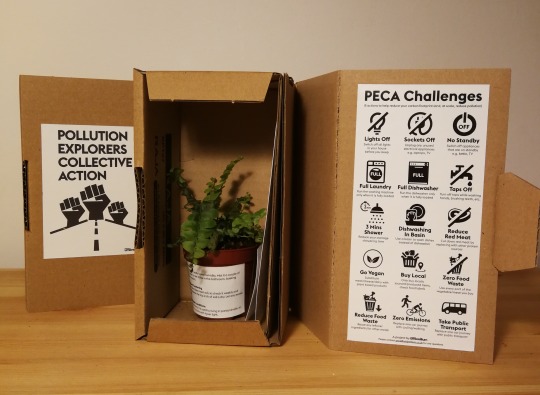
*Image: PECA Plants & Challenges
Read our newsletter, Collective Action & Imagining the Future of Cities, and subscribe to get more on the work that Umbrellium is doing around the world and what’s going on in urban technology every other month right in your inbox.
#news#blog#umbrellium#engaged cities#engaged citizens#collective action#air pollution#re-imagine#thefutureofcities#postcovid
0 notes
Text
Shortlisted for the Leeds City Square RIBA contest

*Another Life for City of Bradford by Umbrellium
We are delighted to be part of a team led by Gillespies, shortlisted by the RIBA for the next stage of a design competition to reimagine Leeds City Square as a space reflecting the city’s cultural richness and climate change ambition.
We look forward to working with Gillespies and Arup, with whom we collaborated a decade ago on one of our biggest projects - Another Life for the City of Bradford - and to meeting EFFEKT and being part of such a skilled and innovative team.
More than 40.000 people cross the square everyday and it is often the first space visitors experience when arriving in the city. What will it take to engage citizens with the square’s surroundings?
Read more about the contest here.
0 notes
Text
Newsletter 006 Uncertain Emotions & Ambiguous Wishes
Our last newsletter of 2020 is live with a message for Christmas and the year coming, and a mention of our latest project aiming to complement cities’ ambitious strategies for mitigating the climate crisis.

Read our newsletter, Uncertain Emotions & Ambiguous Wishes, and subscribe to get more on the work that Umbrellium is doing around the world and what’s going on in urban technology every other month right in your inbox.
2 notes
·
View notes
Text
Newsletter 005 Learning Together Learning Nothing and Learning Patiently
Our fifth newsletter is now live. You can find more information on the open call for the recruitment of participants to join our air quality project and reflections on our learnings with others, machines and eco-data.
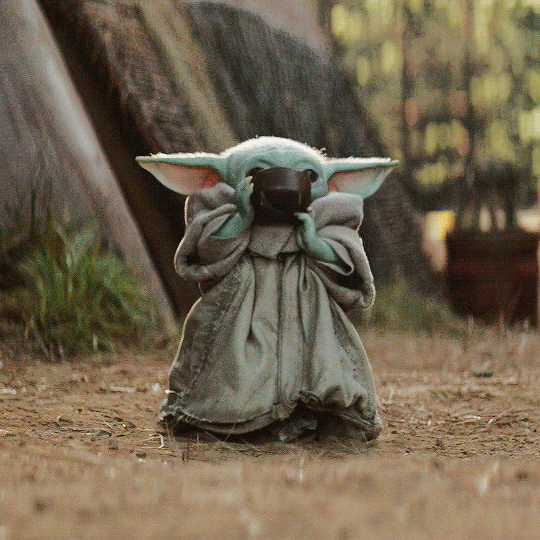
Read our newsletter, Learning Together, Learning “Nothing” and Learning Patiently, and subscribe to get more on the work that Umbrellium is doing around the world (remotely) and what’s going on in urban technology every other month right in your inbox.
0 notes
Text
Pollution Explorers Collective Action
Working Together to Tackle Air Quality
It seems to be a common-sense notion that if we work together to achieve something – like improving air quality – we would do better than working alone. Why, then, are air quality projects so often framed around individual rather than collective action and responsibility; or prioritise data gathering and awareness rather than improvement and impact? There are probably a number of reasons, but in part it is because initiatives founded on collective action and impact are complex – complex to describe, complex to deliver and complex to evaluate.
As part of our ongoing Pollution Explorers series, we recently kicked off a new project to explore this more deeply. Building on research by Dr. Gyorgyi Galik, and supported by a Nesta’s Collective Intelligence Grant, we plan to evaluate a collective action methodology that, though complex to describe and deliver, we believe could be more effective than typical approaches to participatory air quality projects.
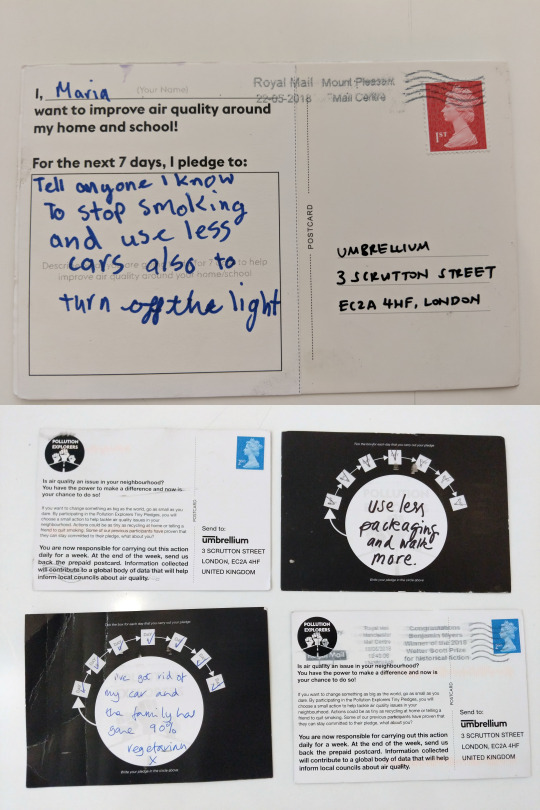
*Photo: participants’ pledges from a Pollution Explorers workshop.
The Pollution Explorers Collective Action (PECA) experiment presents a novel approach to air quality projects focused on community-based behaviour-change, by employing a range of collective action strategies that weave together people’s understanding, commitment, action and impact. We aim to demonstrate how this new approach, while more complex than typical approaches, has deeper and more persistent results. Typical initiatives, particularly those carried out by local authorities, use a combination of education, awareness-raising and information (often mediated by technology like sensors) to try to bolster behaviour change in individuals. These persuasive approaches to reduce pollution and promote behaviour change sometimes use competition and reward-based intervention to incentivise participation, but usually only work with small groups of participants and there is limited evidence of lasting impact at scale.
The approach that we’re testing over the next few months is founded on collective activation and action and builds on insights from social psychology on getting people to work better together – particularly supporting each other in order to achieve things they are unlikely to on their own. We hope to show that, by providing participants with a collective approach to communication, feedback, planning and action and, as demonstrated by Dr Galik in her research, by employing a constantly changing variety of interaction paradigms over the course of the experiment depending on a group’s internal dynamics groups, they will be more successful in sustaining behaviour change for actions that are known to reduce air pollution, even though they may be unable to see the individual effects they have on air pollution directly. Eventually we hope to be able to present a cost-benefit analysis that shows that complex air quality projects that promote collective action are more effective – both environmentally and financially.
If you live in East London and you’re interested to take part, please email [email protected] at Loop Labs, our community partner for the project.
#PECA#engaged citizens#engaged city#collective behaviour change#agency#responsibility#governance#airquality#air pollution#blog
0 notes
Text
Learning Nothing
How can we train a machine to recognise the difference between ‘something’ and ‘nothing’? Over the past few months, I have been working with Despina Papadopoulos on an R&D wearable project – Embodied Companionship, funded by Human Data Interaction.
“Embodied Companionship seeks to create a discursive relationship between machine learning and humans, centered around nuance, curiosity and second order feedback loops. Using machine learning to not only train and “learn” the wearers behaviour but create a symbiotic relationship with a technological artifact that rests on a mutual progression of understanding, the project aims to embody and make legible the process and shed some light on the black box.” – Text by Despina Papadopoulos
The project builds on the work we did last year in collaboration with Bless, where we created a prototype of a new form of wearable companion – Stylefree, a scarf that becomes ‘alive’ the more the wearer interacts with it. In Embodied Companionship, we wanted to further explore the theoretical, physical and cybernetic relationship between technology, the wearable (medium), and its wearer.
vimeo
*Stylefree – a collaboration between Despina Papadopoulos, Umbrellium and Bless.
In this blog post, I wanted to share some of the interesting challenges I faced through experimentations using machine learning algorithms and wearable microcontrollers to recognise our body movements and gestures. There will be more questions raised than answers in this post as this is a work in progress, but I am hoping to share more insights at the end of the project.
My research focuses on the use of the latest open-source machine learning library; Tensorflow Lite developed for Arduino Nano Ble Sense 33. Having designed, fabricated and programmed many wearable projects over the years (e.g Pollution Explorers – explore air quality with communities using wearables and machine learning algorithms), large scale performances (e.g SUPERGESTURES – each audience wore a gesture-sensing wearable to listen to geolocated audio stories and perform gestures created by young people) and platforms (e.g WearON – a platform for designers to quickly prototype connected IoT wearables), the board is a step up from any previous wearable-friendly controllers I have used. It contains many useful body-related sensors such as 9 axis inertial sensors, microphone, and a few other environmental sensors such as light and humidity sensors. With the type of sensors embedded, it becomes much easier to create smaller size wearables that can better sense the user’s position, movement and body gestures depending on where the board is placed on the body. And with its TinyML which allows the running of Edge Computing applications (AI), we can start to (finally!) play with more advanced gesture recognition. For the purpose of our project, the board is positioned on the arm of the wearer.

*Image of the prototype wearable of Embodied Companionship
Training a Machine
With the constraints, I started exploring a couple of fundamental questions – How does a machine understand a body gesture or a movement? How does it tell (or how can we tell it to tell…) one gesture apart from another? With any machine learning project, we require training data, it is used to provide examples of data patterns that correspond to user-defined categories of those patterns so that in future the machine can compare streams of data that are being captured to the examples and try to match them. However the algorithm doesn't simply match them, it returns a confidence level that the captured stream of data matches any particular pattern. Tensorflow offers a very good basic tutorial on gesture recognition using the arduino board, however, it is based on recognising simple and big gestures (e.g arm flexing and punching) which are easily recognisable. In order for the machine to learn a wearer’s gestural behaviour, it will involve learning many different types of movement patterns that a person might perform with their arm. So our first task is to check whether we can use this arduino and Tensorflow lite to recognise more than 2 types of gestures.
I started with adjusting various parameters of the machine learning code, for e.g, training more than 2 sets of distinct gestures, training with more subtle gestures, increasing the training data set for each gesture, increasing the epochs. The results were not satisfactory, the board could not recognise any of the gestures with high confidence mainly because each gestural data was not distinct enough for the machine to distinguish and hence it spreads its confidence level to the few gestures that it was taught with. It also highlighted a key question for me, i.e. how would a machine ‘know’ when a gesture is happening and when it is not happening? Without having an explicit button press to signify the start and end of a gesture (which is synonymous to the Alexa or Siri wake-up call), I realised that it would also need to recognise when a gesture was not happening.

*How a gesture/movement is read on the serial plotter through its 3-axis accelerometer data
The original code from the tutorial was based on detecting a gesture the moment a significant motion is detected which could be a problem if we are trying to recognise more subtle gestures such as a slow hand waving or lifting the arm up slowly. I started experimenting with a couple of other ways for the arduino board to recognise a gesture at the ‘right’ time. First, I programmed a button where the wearer presses it to instruct the board to start recognising the gesture while it's being performed – this is not ideal as the wearer will have to consciously instruct the wearable whenever he/she is performing a gesture, but it allows me to understand what constitute a ‘right’ starting time to recognise a gesture. Lastly I tried programming the board to capture buckets of data at multiple short milliseconds time instances and run multiple analysis at once to compare each bucket and determine which bucket’s gesture at any instance returns the highest confidence level. However that does not return any significantly better result, it’s memory intensive for the board and reinforces the challenge, i.e. the machine needs to know when a person is not performing any gesture.
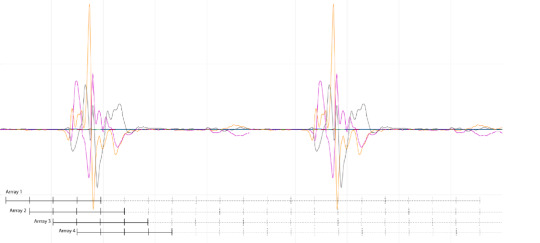
*Capturing buckets of data at multiple short milliseconds time
While the arduino board might be good at distinguishing between 2 gestures, if you perform a 3rd gesture that is untrained for the board, it will return either one of the learnt gestures with very low confidence level. This is because it was not taught with examples of other gestures. However, if we want it to learn a wearer’s behaviour over time, not only do we need to teach the machine with a set of gestures just like any language that comes with a strict set of components e.g alphabets, but it is equally important to teach it to recognise when the wearer is not doing anything significant. And with that it poses a major challenge, i.e. how much training do we need to teach a machine when the wearer is doing nothing?
Making Sense of the Nuances
When it comes to making sense of body gestures, our recognition of any gesture is guided by our background, culture, history, experience and interaction with each other. It is something that in this day and age, an advanced machine is still incapable of doing, e.g recognising different skin colours. Therefore, as much as we can train a machine to learn a body gesture through its x,y, z coordinates, or its speed of movement, we cannot train it with the cultural knowledge, experience or teach it to detect the subtle nuances of the meaning of a gesture (e.g the difference between crossing your arm when you are tired vs when you are feeling defensive).

Photo of one of the SUPERGESTURES workshops where young people design body gestures that can be detected by the wearable on their arm, and represent their story and vision of Manchester
It is worthwhile to remember that while this R&D project explores the extent to which machine learning can help create a discursive interaction between the wearer and the machine, there are limitations to the capability of a machine and it is important for us as designers and developers to help define a set of parameters that ensure that the machine can understand the nuances in order to create interaction that is meaningful for people of all backgrounds and colours.
While machine learning in other familiar fields such as camera vision do have some form of recognising “nothing” (e.g background subtraction), the concept of recognising “nothing” gestures (e.g should walking and standing up be considered ‘nothing’?) for wearable or body-based work is fairly new and has not been widely explored. A purely technological approach might say that ‘nothing’ simply requires adequate error-detection or filtering. But I would argue that the complexity of deciding what constitutes ‘nothing’ and the widely varying concept of what kinds of movement should be ‘ignored’ during training are absolutely vital to consider if we want to develop a wearable device that is trained for and useful for unique and different people. As this is work in progress, I will be experimenting more with this to gather more insights.
A blogpost by Ling Tan
#wearable technology#embodiedcompanionship#machinelearning#gesturerecognition#arduino#humanmachine#humandata#embodiedexperience#blog
0 notes
Text
Newsletter 004 New Beginnings and Viral Reflections
Our fourth newsletter is out, where we announce our third company spin-out, a new project investigating human-machine relationships, and reflections on participation and collaboration to overcome the major issues we face today.
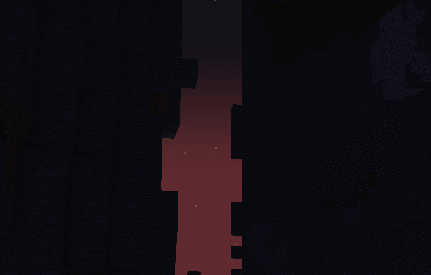
Read our newsletter, New Beginnings & Viral Reflections, and subscribe to get more on the work that Umbrellium is doing around the world and what’s going on in urban technology every other month right in your inbox.
0 notes
Text
Announcing Starling Technologies, our third spin-out!
We are thrilled to announce Starling Technologies Ltd, Umbrellium’s third spin-out company, dedicated to bringing dynamic real time pedestrian safety to junctions and streets, building on our experience creating the world’s first interactive pedestrian crossing in 2017. We are also excited to announce that Starling’s first public deployments will be delivered later this year in collaboration with Colas, a world leader in the construction and maintenance of transport infrastructure.
Andrew Caleya Chetty moves on from Umbrellium to take the helm as Starling Technology’s CEO, while Nitipak ‘Dot’ Samsen, (who gave Umbrellium its name and has been its longest-standing team member apart from Usman!) moves over as CTO. Usman continues as Umbrellium’s creative director but heads up the new company’s strategy and investment opportunities.
Stay tuned for updates by following Starling Technologies on LinkedIn, check out the website https://www.starlingtech.co.uk/ or email [email protected]
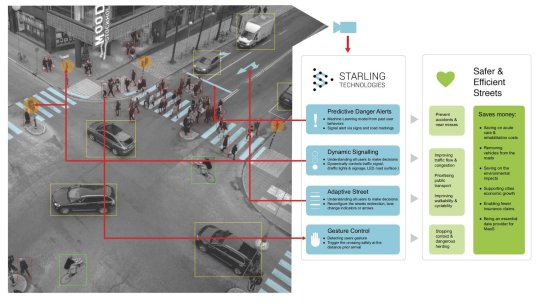
#starlingtechnologies#pedestriansafety#predictionsoftware#neuralnetwork#computervision#roadinfrastructure#announcement#news
0 notes
Text
Newsletter 003 - Transition, Transformation and Participation
Last week we sent out our third newsletter, teeming with updates on the progress of some of our projects, and concluded with a reflection on the future of participation, where we invite you to let us know what is your take on this ‘new abnormal’.

Read our newsletter, Transition, Transformation and Participation, and subscribe to get more on the work that Umbrellium is doing around the world and what’s going on in urban technology every other month right in your inbox.
0 notes